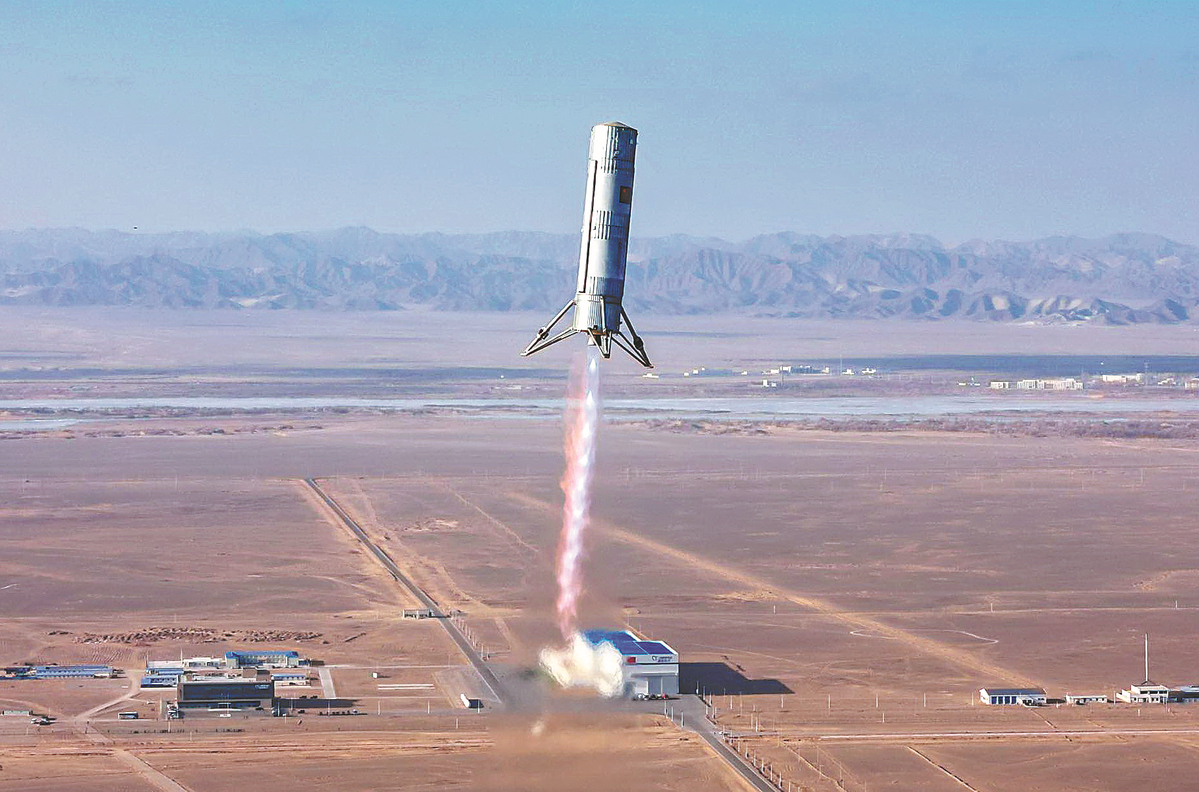Homegrown reusable rocket one step closer
Successful vertical takeoff, landing tests lay 'solid foundation' for flights


A recent test by LandSpace, a leading private space launch company in China, has moved the company closer to its goal of building the nation's first reusable carrier rocket, according to industry observers.
The Beijing-headquartered LandSpace, which shot the world's first methane-propelled rocket into orbit last year, carried out its first "hop test" — in which a rocket lifts off to a certain altitude and then makes a controlled vertical landing — at the Jiuquan Satellite Launch Center in northwestern China's Gobi Desert on Friday.
During the one-minute "vertical takeoff and vertical landing (VTVL)" test, the experimental rocket reached a height of approximately 350 meters and then descended to softly land on a designated point with a descent speed of 0.75 meters per second and an accuracy of about 2.4 meters, according to the company.
The rocket's liftoff weight for the test was 50.3 metric tons, and it can contain more propellants in subsequent tests to a maximum overall weight of 68 tons, designers said.
Powered by a modified 80-ton-thrust TQ 12 methane engine, the experimental vehicle is 18.3 meters tall with a diameter of 3.35 meters, and is made of stainless steel.
"The rocket landed steadily and accurately, and remained in good condition. The flight was a complete success," LandSpace announced after the test, noting it laid a solid technical foundation for the maiden launch of its ZQ 3 reusable rocket.
Yang Yuguang, a senior space industry observer and vice-chair of the International Astronautical Federation's Space Transportation Committee, said on Monday that LandSpace's VTVL test was "significant" because it was a major step toward the completion of the ZQ 3 model, which has been designed to be made of stainless steel.
"Through the test flight, designers could verify the recovery plans of the ZQ 3's first core stage and the performance of the rocket's methane engine, flight control, landing guidance and touchdown buffer systems, and also could test procedures for a reusable rocket's launch, telemetry, recovery as well as maintenance.
"So far, two private Chinese enterprises have conducted VTVL tests of their own methane-fueled rockets, and I am sure they will be joined by more of their peers," he said.
Wang Yanan, chief editor of Aerospace Knowledge magazine, said the use of stainless steel bodies and methane engines has become a shared path for space companies to build reusable, environmentally friendly rockets, which will be pillars of human space exploration in the years to come.
He said the test by LandSpace testified to the company's ability to develop and operate sophisticated rocket technologies previously dominated by foreign companies.
"Private companies around the world are at the forefront of technological innovation in the space industry. We have witnessed the rapid advances made by the Chinese private sector in terms of rocket and satellite technologies, and their achievements will surely strengthen the country's competitiveness and capability in the global space industry," he said.
LandSpace said that based on Friday's success, the company will use the same experimental rocket to make test flights reaching a height of 10 kilometers in the near future, further verifying key technologies for the ZQ 3.
If everything goes according to plan, the first ZQ 3 will be assembled and make its debut flight in 2025.
According to the rocket maker, the ZQ 3 will be 76.6 meters tall and 4.5 meters wide, and will weigh nearly 660 metric tons when fully fueled.
With a liftoff thrust of 900 tons, it will be able to transport spacecraft with a combined weight of 21.3 tons into a low-Earth orbit.
The first stage of ZQ 3 is designed to be reused more than 20 times, said LandSpace.
- Mainland to send support to earthquake-affected areas of Taiwan
- 3 dead in east China residential complex fire
- Risk of infectious illnesses over holiday warns China CDC
- China to honor outstanding workers ahead of Labor Day
- China's robotic spacecraft to be sent to the moon
- Harbin ramps up childcare services




































